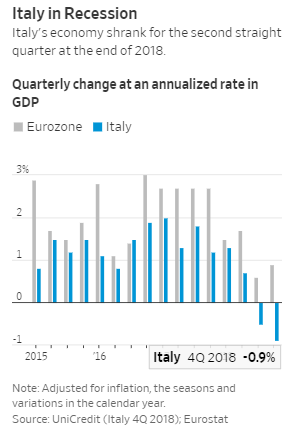The eurozone economy grew at the weakest pace in four years in 2018
By Paul Hannon and Eric Sylvers

Shoppers in Milan on Dec. 27. The drop in Italian consumer confidence weighed on the Christmas shopping season. Photo: Mairo Cinquetti/Zuma Press
The eurozone economy grew at the weakest pace in four years in 2018 as Italy slipped into recession, with a further slowdown likely this year as the currency area faces growing political tensions and the threat of weaker demand for its exports from China and the U.K.
The bloc’s slowdown feeds growing concerns about the strength of the global expansion, which appears to be faltering across a number of major countries and for a variety of reasons.
Earlier in January, China released figures showing growth last year was the slowest in almost three decades. South Korea grew at the slowest pace in six years and Germany the slowest pace in five. Mexico’s economy also cooled, although less sharply.
By contrast, the U.S. economy has been solid, with unemployment holding at a half-century low, although the government shutdown may have sapped growth as 2019 got under way.
Economists expect the eurozone economy to slow further this year and there are a number of potential setbacks that could push the currency area to the brink of stagnation. The U.K. is set to leave the European Union in March, and may do so without a new trade agreement, which could cause severe disruption to eurozone exports.
Furthermore, China’s economy could slow more sharply than expected if a trade dispute with the U.S. isn’t quickly resolved, further weakening its imports from Germany. While Italy’s sales to China are less significant for its economy, Germany is its largest export market.
“When Germany slows down, Italy slows down,” said Marco Valli, an economist at UniCredit Bank in Milan.
The European Union’s statistics agency said Thursday that economic growth in the 19 countries that use the euro was 1.8% last year, down from 2.4% in 2017, which was its strongest performance in a decade. However, there was a slightly pickup in the final three months of 2018, as gross domestic product rose at an annualized rate of 0.9%, compared with 0.6% in the three months through September.
That pickup was aided by Spain, where growth accelerated slightly as the year drew to a close. But the outlook for 2019 is for slower growth, with the German government slashing its growth forecast Wednesday for the year to 1% from 1.8%, pointing to mounting geopolitical and trade risks.
The eurozone economy was hampered by a weakening of exports in 2018, driven by Turkey and the U.K., with Chinese demand also easing.
Closer to home, French President Emmanuel Macron is wrestling with mass protests aimed at derailing his economic-reform plans, while in Germany, holdups at the country’s key automobile factories pushed Europe’s largest economy to the brink of recession in the final six months of last year.
Figures also released Thursday showed Italy’s economy contracted in the final three months of 2018, the second straight quarter of declining output.
That was partly due to a monthslong standoff between the government and the EU over its plans to increase its budget deficit, which pushed borrowing costs higher and dented business and consumer confidence.
The drop in consumer confidence weighed on the Christmas shopping season, especially for smaller retailers that were already struggling.
“It was a bad year in general and a horrible Christmas season,” said Luciano Lasaracina, who runs a small shop in Milan selling handmade shoes.
He is worried about Italy’s slow growth and the uncertain political situation.
Italy’s economy is still smaller than before the double blow of the financial and sovereign debt crises and that has taken a toll on retailers like Mr. Lasarcina. On Saturdays, Mr. Lasaracina used to have five people working with him in his store and might sell as many as 90 pairs of shoes in a single day. Now it is just him and his son on Saturdays and they work on alternate days during the week.
Things don’t look set to pick up soon with the Italian central bank and the International Monetary Fund recently cutting their 2019 growth forecasts for Italy to 0.6% from 1%.
A decade of meager growth has lessened Europe’s importance for the world economy, but it still accounts for more than 15% of global activity and its slowdown has already had an impact beyond its borders.
The Federal Reserve held its benchmark interest rate steady Wednesday.
The Federal Reserve delivered an about-face Wednesday from its policy stance six weeks earlier, indicating that it was done raising interest rates for now, citing growing risks of a sharp U.S. economic slowdown due to cooling growth in Europe and Asia.
As exports cool, the eurozone is set to be increasingly reliant on spending by domestic consumers and businesses to drive its economic expansion. But confidence has been weakened by political tensions, and they may intensify as 2019 progresses.
Elections for the European Parliament in May are a potential flashpoint, since they are expected to produce gains for antiestablishment parties, increasing uncertainty about future economic policy. Based on opinion polls across the bloc, JP Morganestimates that the share of lawmakers from antiestablishment parties could rise to almost a third of the total, from a fifth now.
That rise in uncertainty may hinder necessary upgrades in tools and equipment: A survey of 12,500 European businesses conducted by the European Investment Bank at the end of 2018 found a big increase in those citing political developments as a deterrent to investment.
—Giovanni Legorano contributed to this article.

0 comments:
Publicar un comentario